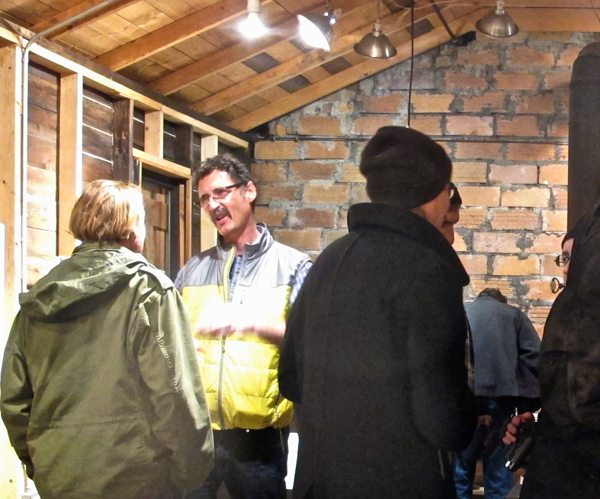
Curator Profile: Steve Panton, Hamtramck’s cultural tour de force
Steve Panton, against a backdrop of his adopted hometown of Hamtramck.
I first got to know artist, engineer and curator Steve Panton through attending art occasions at his gallery space, 2739 Edwin, which offered consistently original and challenging work and workshops. The more I’ve learned about the goings and doings of this man involved in the heart of the Hamtramck cultural landscape, including co-organizing things like the Hamtramck Neighborhood Art Festival and the Hamtramck Free School, the more curious I’ve been to sit him down for a formal interview. Here it is, just in time to introduce Panton’s forthcoming new gallery space, on the main drag of Joseph Campau in Hamtramck. RS: From what I understand, you have a background in engineering.
SP: Yes, it’s true. I started an engineering apprenticeship in 1979 and one way or another earned my living that way until October 2013, when I decided to work full-time on developing a new gallery space. I think there’s been a fairly complex relationship over the last six years between my “dual careers” as an engineer and running the gallery. On the one hand, the skills I developed as an engineer have obviously informed what I do at the gallery; on the other hand, I have been committed to keeping the gallery ideologically autonomous from the prevailing technological/capitalist orthodoxy.
How did you come to art, as a scene and a practice?
In terms of the art scene (if you want to use that term) in Detroit, I came across it through walking around the city in the late 90s, early 2000s, and wandering into galleries like Alley Culture and Tangent. In parallel, I was very involved in personal projects investigating Detroit’s history and our relationship to place in general. Sherry Hendricks (from Alley Culture) somehow recognized that these projects could be shown in a gallery setting and organized a show around them in 2003. After that, one thing led to another, and before I knew it, I had a gallery space. One thing you can say about Detroit is that the consumer/creator divide is very porous.
What inspired the art space at 2739 Edwin?
I felt that there were too many group shows in the city, that the same “voices” were being featured over and over again, and there was a general lack of criticality. I wanted a space where solo artists could stretch out and show meaningful work, where new voices could be heard, and where serious issues could be discussed in an inclusive manner. It ran from March 2008 to October 2013 and had about 25-30 shows plus various other events. I was very fortunate with the physical space, which was perfect for my needs and allowed me to “punch above my weight” in terms of attracting artists and building an audience. What role do you see historians playing in regards to art and/or modern society?
Basically I think that if there’s any hope in addressing issues of the environment and social justice, we all have to become historians. So I would turn the question around and ask what role art, or more accurately activities that can take place in an art gallery, might play in this.

Panton (middle, facing camera) at the Alley Culture opening in November of 2013.
I really enjoyed the piece about railroad history that you installed at Alley Culture back in November. That’s the first instance I’ve seen of your own art-making. Do you make much art, or would you consider that more of a history project? Do you have other work I should know about?
I’m always working on a few long-term projects – normally they involve some element of historical research and some direct experiential component (typically walking). I’m not sure if it matters whether they’re art or not, but ultimately they normally find their way into a gallery setting in one form or another. Probably the most ambitious project I undertook was in my hometown of Nottingham, when I took two photos a day and wrote two paragraphs a day for 100 days on the history of the city and my family’s relationship to it. Eventually I publicly displayed the photos and resulting text (alongside related graphite on paper work by Detroit artist Kathy Rashid) in a gallery close to where I was staying at the time.
You’ve mentioned how you are really in the art game to achieve fame and earn a lot of money, which I fail to see reflected in your humility and modest lifestyle. What’s your real motivation, Mr. Panton?
I don’t know, sometimes you just have to do things because they seem right.

Panton (center) in a discussion following a Free School class at the Hamtramck Historical Museum.
2739 Edwin is in the process of moving to a new location in Hamtramck with the intention of re-starting operations as 9338 Campau in summer 2014. The first show at the new location will be a survey of the career and influences of Detroit artist M. Saffell Gardner.
Recent Content
-
Artsarticle ·
-
Artsarticle ·
-
Artsarticle ·
